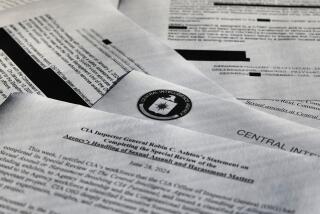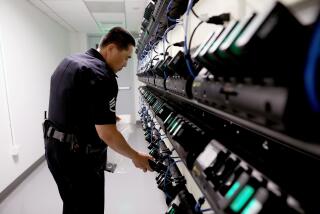CIA should tape more, experts say
- Share via
WASHINGTON — The controversy over destroyed CIA videotapes has highlighted weaknesses in American intelligence agencies’ methods of interrogation of Al Qaeda suspects, according to current and former officials and experts, who say those methods are compromising the ability to extract critically important information about the threat from Islamic extremism.
Congress, the Justice Department and the CIA inspector general are investigating why the CIA destroyed tapes of its 2002 interrogations of two alleged senior Al Qaeda leaders, Abu Zubaydah and Abd al Rahim al Nashiri. Investigators think Zubaydah was recorded being waterboarded -- a controversial tactic that mimics the experience of drowning. The tapes were destroyed in 2005.
By their own accounting, the CIA and other U.S. intelligence agencies have not videotaped the interrogations of potentially hundreds of other terrorism suspects. That indicates an outmoded level of secrecy and unprofessionalism, the interrogation experts contend.
They say that the U.S. is behind the curve of current best practices, and that videotaping is an essential tool in improving the methods -- and results -- of terrorism interrogations. And the accountability provided by recording is needed to address international concerns about the United States’ use of harsh, potentially illegal techniques, these experts add.
They say that the United States could learn a lot from methods used by Israel, Britain and other countries with decades of experience in interrogating terrorists but that so far, it has not.
“We are operating in a vacuum,” said Col. Steven M. Kleinman, a reserve senior intelligence officer for the Air Force’s Special Operations Command who was a military interrogator in Panama, during the 1991 Persian Gulf War, and in Iraq in 2003. “We are not giving our interrogators the skill set or the tool chest to get the information that we need in the war on terrorism.”
Kleinman is one of several government experts participating in a study of interrogation for the Intelligence Science Board, an advisory body of the national intelligence director’s office and other U.S. intelligence agencies.
Last year the board issued its first report, a politely worded but critical document titled “Educing Information: Interrogation: Science and Art.” It concluded that the U.S. government had not in any scientific manner studied the effectiveness of its methods of interrogation since the end of World War II and that it was still using the same unproven techniques.
Time to ‘professionalize’
If the CIA had videotaped its interrogations of as many as 100 “high-value” terrorism suspects, Kleinman and other study participants said, then details could have been archived for in-depth comparison and analysis by a range of government experts.
“It is essential to take this craft to the next level and professionalize it,” Kleinman said.
CIA spokesman George E. Little said he could not discuss internal interrogation practices, including whether the CIA had reviewed terrorism interrogation videos recorded by countries that work closely with the United States.
“The fact of the matter is that the careful, professional and lawful questioning of hardened terrorists has produced thousands of intelligence reports, revealed exceptionally valuable insights on Al Qaeda’s operations and organization, foiled terrorist plots, and saved innocent lives,” said Little.
The Intelligence Science Board’s report concluded that U.S. intelligence agencies had done so little questioning of hostile subjects since the 1950s that individual interrogators “were forced to ‘make it up’ on the fly” after the Sept. 11 attacks. And little has changed since then, the report said.
“This shortfall in advanced, research-based interrogation methods . . . may have contributed significantly to the unfortunate cases of abuse that have recently come to light,” such as Abu Ghraib and the controversy over the CIA’s interrogation of suspects, the report said.
The board issued recommendations this year about how the government should improve interrogation efforts, including identifying ways to build a cadre of well-trained professionals who could use noncoercive techniques in line with international norms.
Those recommendations have gone largely unheeded, several study participants said.
“There doesn’t seem to be a core agency in the U.S. government that has this on its radar screen,” said participant Randy Borum, a forensic psychologist who recently served as the principal investigator on a “Psychology of Terrorism” initiative for U.S. intelligence agencies.
The report said the government needed to conduct more research on whether coercive methods ever work.
Such methods are sometimes necessary, said one counter- terrorism official.
“If someone is implying that professional interrogation always has to involve rapport-building and stroking, I wouldn’t want to defend that position were the country facing an imminent terrorist attack,” said the official, who spoke on condition of anonymity because the U.S. interrogation program is classified. “Some people think that Perry Mason-style questioning works against hardened terrorists. That’s sometimes not the case.”
Debating the tapes’ value
Current investigations aim to determine why the CIA destroyed the tapes in 2005 and why it had stopped making new ones in 2002.
CIA Director Michael V. Hayden has said that the agency destroyed the tapes largely to protect the identities of the interrogators.
Hayden also has said that the tapes were destroyed only after they were determined to be of no further intelligence value, and that detailed summaries of the interrogations of Zubaydah and Nashiri were cabled back to headquarters, where they became “the products that our analysts use to create the actionable intelligence that we move on.”
But much of the value of an interrogation cannot be captured in a summary of it, or even a transcript or audiotape, according to retired CIA case officer Robert Baer.
He said that when he was overseeing terrorism investigations in the 1980s and 1990s, he videotaped as many interrogations as possible because it would often take years for a single utterance, bit of body language or other visual clue to become relevant.
“So when Hayden says there is no intelligence value there, he is patently wrong,” said Baer.
“The largest criminal case in American history, and we don’t keep the evidence?
“Come on.”
Interrogation 101
Such interrogations are often marathons over a period of days, weeks or months.
Visual cues known as psychometrics are invaluable in helping detect whether someone is lying and in yielding a host of other important clues, said Magnus Ranstorp, a veteran counter- terrorism expert with the Swedish Defence College.
He said that some foreign intelligence agencies videotape their interrogations and others don’t, but that all of them should.
“You have a unique moment when you engage the adversary. The way we communicate, the way we react and conceal, can be more revealing than what we say . . . and none of that shows up on a transcript,” Ranstorp said.
“It’s Interrogation 101,” he said.
If agencies don’t save and analyze tape, Ranstorp said, “they have been derelict in their duty.”
Kleinman, an interrogation instructor for the Pentagon and some foreign governments, said that such videotapes are an invaluable research and teaching tool in determining which techniques work. He also said that tapes allow supervisors to vet the intelligence gained and determine whether interrogators failed to ask important questions, asked leading questions, or used inappropriate or possibly illegal tactics.
Many interrogation experts, including some involved in the ongoing Intelligence Science Board study, say they have urged U.S. intelligence officials to look to Israel, Britain and other countries with decades of experience in dealing with terrorism to learn from their successes -- and their mistakes.
Israel and Britain both adopted a scientific approach to interrogations long ago, using videotape and other documentary evidence to help determine which techniques work and which don’t in getting violent extremists to disclose operational details of their networks and more strategic subjects such as what motivated them in the first place.
Rapport versus coercion
Dropping coercive methods that it had used on Irish Republican Army members, Britain developed noncoercive techniques that have served it well in dealing with Islamic extremists since Sept. 11, according to Louise Richardson of the Radcliffe Institute for Advanced Study at Harvard University, who has studied Britain’s interrogations of IRA militants for decades.
Israel also dropped coercive techniques and now spends months interviewing terrorism suspects and convicts, establishing a rapport with them and then getting them to open up, said Amos N. Guiora, a former senior Israeli counter-terrorism official and judge.
The results are then added to a comprehensive database of terrorists and are studied for trends.
Israel’s methodical research has provided breakthroughs into how to persuade individuals not to become terrorists in the first place, how to create dissension within their ranks, and how to marginalize terrorist organizations and delegitimize their leadership, according to Dr. Jerrold Post, a psychiatrist who used to be the CIA’s top psychological profiler.
Richardson said the United States’ continued reliance on coercive techniques shows that it has far to go in understanding what kinds of interrogation methods work.
She wrote the 2006 book “What Terrorists Want: Understanding the Enemy, Containing the Threat.”
“The U.S. is repeating the same mistakes that other democracies have made,” she said.
“They overreact initially by relying on force, and over time learn that force is not the most productive response.”
More to Read
Sign up for Essential California
The most important California stories and recommendations in your inbox every morning.
You may occasionally receive promotional content from the Los Angeles Times.










